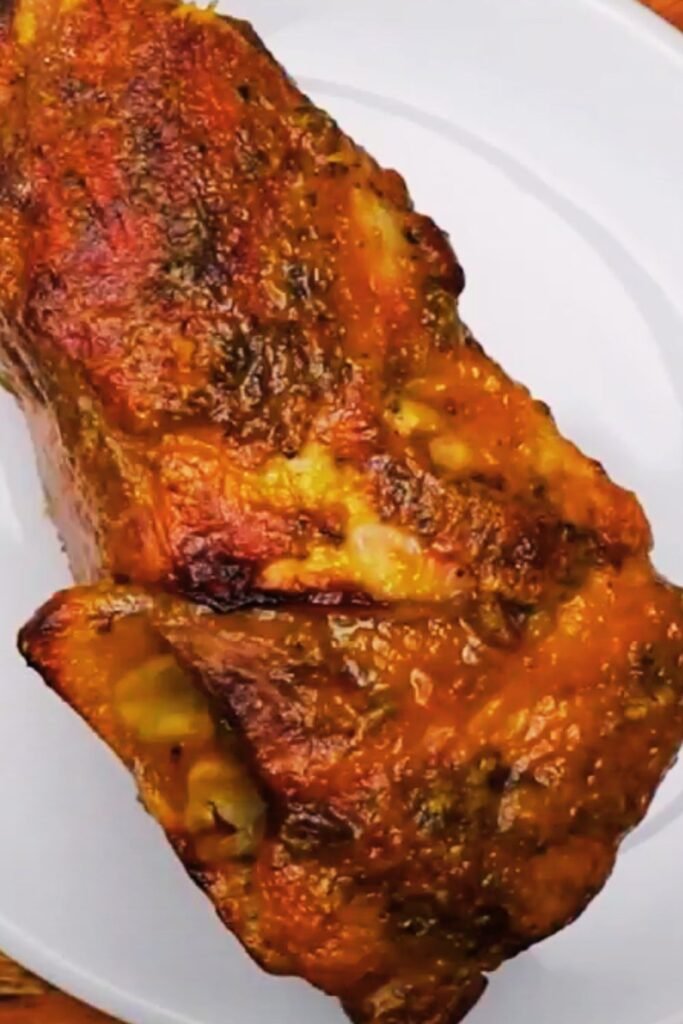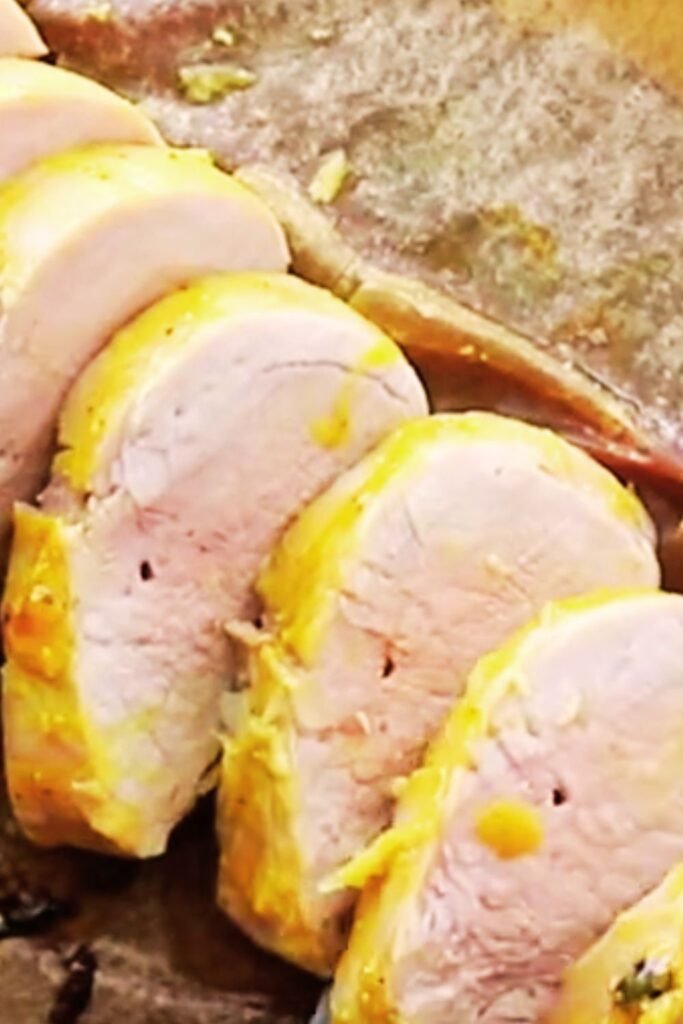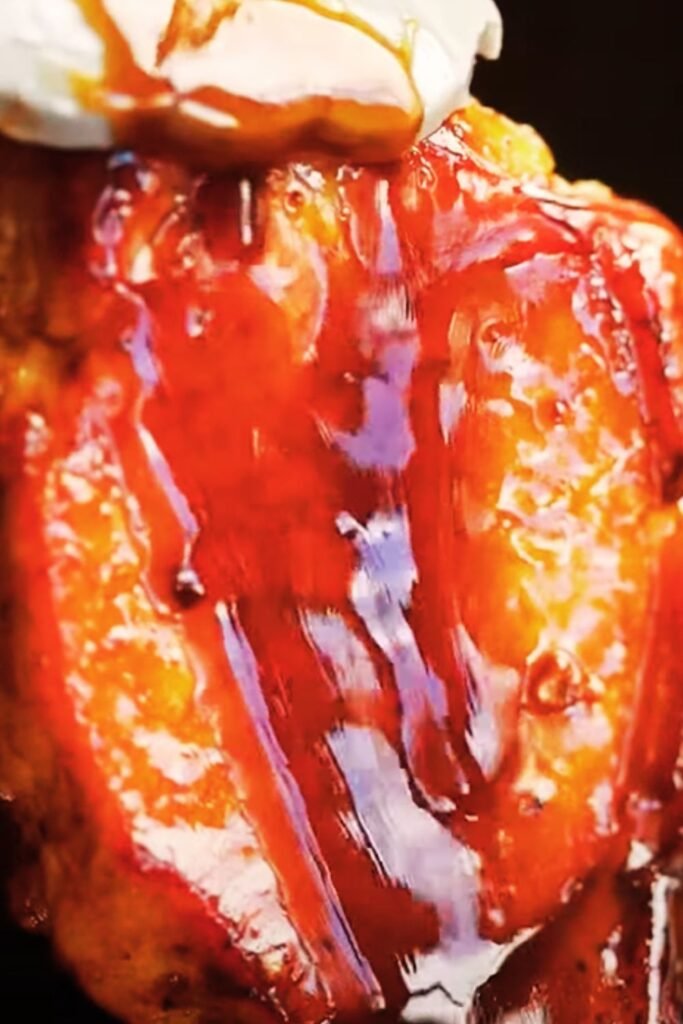I’ve been perfecting this Brown Sugar Dijon Glazed Pork Loin recipe for years, and I can confidently say it’s become one of my signature dishes. The combination of tangy Dijon mustard and rich brown sugar creates a glaze that transforms an ordinary pork loin into something extraordinary. Whether you’re hosting a dinner party or preparing a special family meal, this recipe delivers restaurant-quality results every time.
The beauty of this dish lies in its simplicity and the incredible depth of flavor achieved through the perfect balance of sweet and savory elements. The glaze caramelizes beautifully during cooking, creating a gorgeous golden-brown exterior while keeping the pork tender and juicy inside.
Understanding Pork Loin: The Foundation of Great Flavor
Before diving into the recipe, let me share what I’ve learned about selecting and preparing pork loin. This cut comes from the back of the pig and is naturally lean, which makes it perfect for glazing techniques. The key is not to overcook it, as lean meat can quickly become dry.
Pork Loin Selection Guide:
- Center-cut pork loin: The most tender and evenly shaped portion
- Bone-in vs. boneless: I prefer boneless for easier carving and more even cooking
- Weight considerations: 2-3 pounds serves 6-8 people comfortably
- Fat cap: Look for a thin layer of fat on one side for added flavor and moisture
Essential Ingredients for the Perfect Glaze
My glaze recipe has evolved over countless cooking sessions, and I’ve found that quality ingredients make all the difference. Here’s what you’ll need:
For the Pork Loin:
- 2.5-3 pound boneless pork loin, trimmed
- 2 tablespoons olive oil
- 1 teaspoon kosher salt
- 1/2 teaspoon black pepper
- 1/2 teaspoon garlic powder
- 1/2 teaspoon dried thyme
For the Brown Sugar Dijon Glaze:
- 1/3 cup packed dark brown sugar
- 3 tablespoons Dijon mustard
- 2 tablespoons honey
- 2 tablespoons apple cider vinegar
- 2 cloves garlic, minced
- 1 tablespoon soy sauce
- 1 teaspoon fresh rosemary, chopped
- 1/4 teaspoon red pepper flakes (optional)
Detailed Cooking Instructions
Preparation Phase
I always start by bringing the pork loin to room temperature about 30 minutes before cooking. This ensures even cooking throughout the roast. While the pork is tempering, I prepare my glaze and preheat the oven to 425°F (220°C).
Step 1: Seasoning the Pork Pat the pork loin completely dry with paper towels. I cannot stress this enough – moisture is the enemy of a good sear. Rub the olive oil all over the surface, then season generously with salt, pepper, garlic powder, and thyme. The seasoning should form a light coating on all sides.
Step 2: Preparing the Glaze In a medium bowl, whisk together the brown sugar, Dijon mustard, honey, apple cider vinegar, minced garlic, soy sauce, rosemary, and red pepper flakes if using. The mixture should be smooth and well combined. If the brown sugar seems lumpy, I sometimes warm it slightly in the microwave for 15-20 seconds to help it dissolve.

Cooking Process
Step 3: Searing the Pork Heat a large oven-safe skillet over medium-high heat. When the pan is hot, add the seasoned pork loin and sear for 2-3 minutes per side until golden brown all around. This step is crucial for developing flavor and creating a beautiful presentation.
Step 4: Initial Roasting Transfer the skillet to the preheated oven and roast for 15 minutes. This initial high-heat phase helps develop the exterior while beginning to cook the interior.
Step 5: Glazing Process Remove the pork from the oven and brush half of the glaze over the entire surface. Return to the oven and continue roasting for another 10-15 minutes, depending on the size of your roast.
Step 6: Final Glaze Application Apply the remaining glaze and continue cooking until the internal temperature reaches 145°F (63°C) as measured with a meat thermometer inserted into the thickest part of the roast.
Temperature and Timing Guidelines
Getting the temperature right is absolutely critical for this recipe. I’ve created this detailed guide based on my extensive testing:
| Pork Loin Weight | Initial Searing Time | First Roasting Phase | Glazing Phase | Total Cooking Time |
|---|---|---|---|---|
| 2 lbs | 8-10 minutes | 15 minutes | 15-20 minutes | 40-45 minutes |
| 2.5 lbs | 10-12 minutes | 15 minutes | 20-25 minutes | 45-50 minutes |
| 3 lbs | 12-14 minutes | 15 minutes | 25-30 minutes | 50-55 minutes |
| 3.5 lbs | 14-16 minutes | 20 minutes | 30-35 minutes | 60-65 minutes |
Internal Temperature Guide
| Doneness Level | Internal Temperature | Texture Description |
|---|---|---|
| Medium-rare | 135°F (57°C) | Slightly pink, very juicy |
| Medium | 145°F (63°C) | Light pink center, juicy |
| Medium-well | 150°F (66°C) | Barely pink, still moist |
| Well-done | 160°F (71°C) | No pink, drier texture |
I strongly recommend aiming for 145°F for the perfect balance of safety and juiciness. The pork will continue cooking from residual heat during the resting period.
Resting and Carving Techniques
After removing the pork from the oven, I always let it rest for 10-15 minutes before carving. This resting period allows the juices to redistribute throughout the meat, ensuring every slice is moist and flavorful.

Carving Tips:
- Use a sharp carving knife for clean cuts
- Slice against the grain for maximum tenderness
- Aim for 1/2-inch thick slices
- Arrange on a warm platter to maintain temperature
Flavor Profile and Variations
The classic Brown Sugar Dijon glaze creates a beautiful harmony of flavors. The brown sugar provides deep, molasses-like sweetness, while the Dijon mustard adds tangy complexity. The honey contributes floral notes, and the apple cider vinegar brightens the entire profile.
Seasonal Variations I Love:
- Fall Version: Add 1 tablespoon maple syrup and 1/2 teaspoon ground cinnamon
- Spring Version: Include 2 tablespoons fresh chopped herbs (thyme, rosemary, sage)
- Summer Version: Add 1 tablespoon fresh orange zest and 1/4 cup orange juice
- Winter Version: Include 1 tablespoon bourbon and 1/2 teaspoon smoked paprika
Nutritional Information
Understanding the nutritional content helps me make informed decisions about serving sizes and meal planning:
| Nutrient | Per 4 oz Serving | % Daily Value |
|---|---|---|
| Calories | 285 | 14% |
| Protein | 32g | 64% |
| Total Fat | 8g | 12% |
| Saturated Fat | 3g | 15% |
| Carbohydrates | 18g | 6% |
| Sugars | 16g | – |
| Sodium | 425mg | 18% |
| Cholesterol | 85mg | 28% |
Side Dish Recommendations
I’ve experimented with countless side dishes over the years, and these combinations never fail to impress:
Classic Pairings:
- Roasted root vegetables (carrots, parsnips, sweet potatoes)
- Garlic mashed potatoes or herb-roasted fingerlings
- Steamed green beans with almonds
- Wild rice pilaf with cranberries
- Sautéed spinach with garlic
Seasonal Suggestions:
- Spring: Asparagus with lemon and fresh herbs
- Summer: Grilled corn and zucchini medley
- Fall: Roasted Brussels sprouts with bacon
- Winter: Braised red cabbage with apples
Make-Ahead and Storage Tips
One of the reasons I love this recipe is its flexibility for meal planning. The glaze can be prepared up to three days in advance and stored in the refrigerator. I often season the pork loin the night before cooking for even better flavor development.
Storage Guidelines:
- Cooked pork loin: 3-4 days in refrigerator
- Glaze separately: Up to 1 week in refrigerator
- Frozen cooked pork: Up to 3 months (wrap tightly)
Reheating Instructions:
- Oven: 325°F for 15-20 minutes, covered with foil
- Microwave: 50% power, 2-3 minutes per slice
- Stovetop: Gentle warming in covered pan with a splash of broth

Troubleshooting Common Issues
Through years of making this recipe, I’ve encountered and solved various challenges:
Problem: Glaze Burns During Cooking Solution: Apply glaze in stages and tent with foil if browning too quickly
Problem: Pork Turns Out Dry Solution: Use a meat thermometer and don’t exceed 145°F internal temperature
Problem: Glaze Won’t Stick Solution: Ensure pork surface is dry before applying glaze; score fat cap lightly
Problem: Uneven Cooking Solution: Bring pork to room temperature before cooking; use consistent oven temperature
Advanced Techniques for Perfect Results
After mastering the basic recipe, I’ve developed several advanced techniques that take this dish to the next level:
Brining for Extra Moisture: I sometimes brine the pork loin for 4-6 hours before cooking. Mix 4 cups water, 1/4 cup kosher salt, and 2 tablespoons brown sugar. This optional step adds incredible moisture and flavor.
Reverse Searing Method: For even more control, try cooking at 275°F until the internal temperature reaches 135°F, then finish with a high-heat sear for the glaze.
Glaze Reduction: Save some glaze and reduce it in a small saucepan until thickened for an elegant sauce to drizzle over the sliced pork.
Wine and Beverage Pairings
The sweet and savory profile of this dish pairs beautifully with various beverages:
Non-Alcoholic Options:
- Sparkling apple cider with cinnamon
- Pomegranate juice with soda water
- Iced tea with fresh herbs
- Cranberry juice with lime
Leftover Recipe Ideas
I never waste leftover pork loin! Here are my favorite ways to repurpose it:
- Pork Loin Sandwiches: Slice thin and serve on crusty bread with arugula
- Asian-Style Salad: Dice and toss with mixed greens, mandarin oranges, and sesame dressing
- Breakfast Hash: Cube and sauté with potatoes, onions, and bell peppers
- Pasta Addition: Slice and add to creamy pasta dishes or grain bowls
Questions and Answers
Q: Can I use a different type of mustard instead of Dijon? A: While Dijon provides the best flavor balance, you can substitute with whole grain mustard or even yellow mustard. Whole grain mustard adds texture, while yellow mustard will be milder and slightly sweeter.
Q: How do I know when the pork is done without a thermometer? A: While I strongly recommend using a meat thermometer, you can check by making a small cut in the thickest part. The meat should be slightly pink in the center with clear juices running out.
Q: Can I cook this on a grill instead of in the oven? A: Absolutely! Use indirect heat at medium temperature (around 350°F). Follow the same timing guidelines, but watch carefully as grill temperatures can vary.
Q: What if I don’t have apple cider vinegar? A: You can substitute with white wine vinegar, rice vinegar, or even white vinegar. Each will provide the necessary acidity, though the flavor will be slightly different.
Q: Can I double the glaze recipe? A: Yes, doubling the glaze works well if you’re cooking multiple pork loins or want extra sauce for serving. Store any leftover glaze in the refrigerator for up to a week.
Q: Is it safe to eat pork at 145°F? A: Yes, according to USDA guidelines, pork is safe to consume at 145°F followed by a 3-minute rest period. This temperature ensures food safety while maintaining juiciness.
Q: Can I prepare this dish ahead for entertaining? A: You can season the pork and prepare the glaze up to 24 hours ahead. However, I recommend cooking it fresh for the best texture and flavor.
Q: What’s the best way to slice the pork loin? A: Use a sharp knife and slice against the grain in 1/2-inch thick pieces. Let the meat rest for 10-15 minutes before slicing to retain juices.
This Brown Sugar Dijon Glazed Pork Loin has become one of my most requested recipes, and I’m confident it will become a favorite in your kitchen too. The combination of simple techniques and quality ingredients creates a dish that’s both impressive and approachable. Remember, cooking is about more than just following instructions – it’s about understanding your ingredients and adjusting to your taste preferences. Don’t be afraid to make this recipe your own by experimenting with different herbs, spices, or glaze variations.
The key to success lies in patience and attention to detail. Take your time with each step, use a reliable meat thermometer, and always let the meat rest before carving. These small but important details make the difference between a good meal and an unforgettable one.